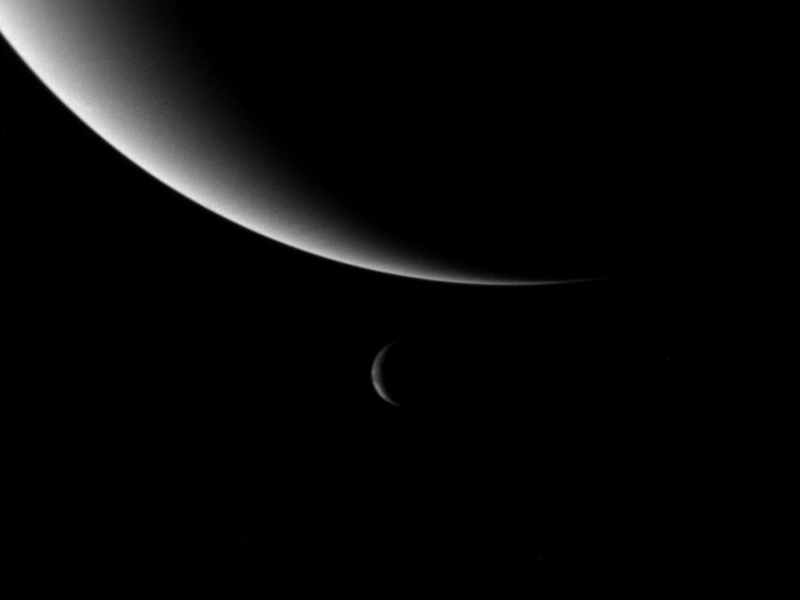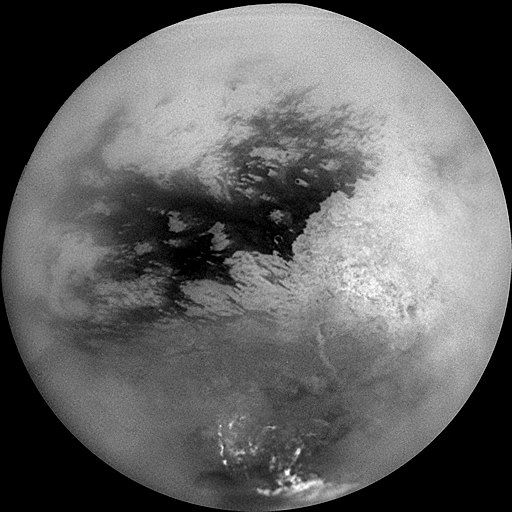Which Two Planets Have the Most Moons - 2020 edition
I first wrote about this ten years ago in 2010 (read that post here) but perhaps counterintuitively things change quickly in astronomy[1]. So what's new?
Some of the numbers have changed, and there are some key updates in a few of the specifics which I'll touch on for each of the planets below, but something you'll notice immediately is that there is a new #1. Before I get into the top 10[2] I'll say that the list hasn't changed because anything has gained (or lost) any moons; it's our understanding and knowledge that has changed. Also, I'll do it backwards this time because that's more fun. And traditional.
10. Mercury: 0
Mercury has no moons. This is probably because it's so close to the Sun, which really narrows the region in which a moon could be formed or captured: too distant and it would be disturbed by the Sun's gravitational field. Too close, and it would be broken up by tidal forces.
9. Venus: 0
Venus has no moons either, although there was a period (from 1645 to about 1770) in which a number of astronomers thought they'd caught sight of something orbiting Venus. It was even named ("Neith") but there were no new sightings after that time or, crucially, during the Venus transits of 1761 and 1769 (which rocked astronomy and had repercussions that changed the world in other ways as well).
8=. Orcus, Salacia, Quaoar, Makemake, Varda, Gonggong, Eris & Earth: 1 each
The first seven of these are dwarf planetsFOOTENOTE4 rather than planets but I wanted a top 10 rather than a top 8 and this is my blog, so my rules.
Orcus is probably a dwarf planet and very definitely falls into possibly the cutest-named group of minor plants, the "Plutinos". Its moon is called Vanth and is about 440km in diameter.
TNO Salacia's moon, Actaea is, at around 300km in diameter, around one third the size of its host.
Quaoar's moon, Weywot, was discovered in 2007 and is estimated to be about 170km in diameter.
Makemake's moon has the catchy name "S/2015(136472)1" (or "MK2" to its friends). It's a little bigger than Weywot.
Ilmarë is Varda's moon, which (at 326km across) is almost half the diameter of Varda itself.
Gonggong's moon Xiangliu was discovered during an analysis of archived images from the Hubble Space Telescope in 2010.
Eris is the known dwarf planet with the largest mass, and its moon, Dysnomia, may be the second-largest moon of a dwarf planet, in the region of 700km in diameter.
Earth you've heard of (I hope), and its moon is the imaginatively titled The Moon. You may have heard reports of other moons of Earth but these are often speculation, hoaxes, or poor journalism regarding quasi-satellites, trojans and temporary satellites[5].
7. Haumea: 2
Haumea is another trans-Neptunian dwarf planet. It has two moons, Hi'iaka and Namaka. The three bodies are thought to be the result of a collision causing the break-up of a larger body at some point in the distant past.
6. Mars: 2
Mars's two moons are Phobos and Deimos, both of which are very small in comparison with the planet they orbit (see image below for comparison).

|
| Mars, Phobos and Deimos (sizes and distances to scale). They're there, honest (Nbound at English Wikipedia / Public domain) |
5. Pluto: 5
Back in 2010 we only knew about 3 of them. Pluto's not a planet, but as I already laid the groundwork back at #8 for included dwarf planets so everything's fine. Its moons are, in order from closest to furthest from Pluto, Charon (the most well known and massive enough to be vaguely spherical at about half the diameter and one-sixth the mass of Pluto), Styx, Nix, Kerberos and Hydra (which are all much smaller).
4. Neptune: 14
One more than we knew about in 2010. The new one, Hippocamp, was discovered in 2013 and is 6th closest to Neptune and the smallest of its moons at just under 35km in diameter. The largest (and earliest discovered) is Triton, which was discovered on my -136th birthday, just 17 days after the discovery of Neptune itself in 1846.

|
| A photograph of Neptune (top) with Triton (bottom) by Voyager 2 on it's fly-by in 1989 (Attribution: NASA / Jet Propulsion Lab / Public domain) |
3. Uranus: 27
Unchanged since last time the 27 moons of Uranus are mostly named after characters from William Shakespeare's plays. Five of them are massive enough to have reached hydrostatic equilibrium (i.e. they're pretty close to being spherical) and these are (in order of increasing distance from Uranus) Miranda, Ariel, Umbriel, Titania and Oberon. These last two were the first to be discovered in 1787. The most recently discovered were Cupid, Mab, Francisco, Margaert and Ferdinand, all in 2003.
2. Jupiter: 79
Down to second place is Jupiter with 79 moons (up from 63 in 2010). The most recently discovered is Ersa, about 3 kilometres in diameter and positioned 12th in order of average distance from Jupiter. The joint-first to be discovered (and largest) were Ganymede, Io, Callisto and Europa (in descending order of size) by Galileo Galilei in 1610.

|
| From left: Io, Europa, Ganymede and Callisto (in order of increasing distance from Jupiter - distances not to scale!) (Attribution: NASA/JPL/DLR / Public domain) |
1. Saturn: 82
Yes, that leaves Saturn in the top spot with 82 known moons (up from 62 in 2010). The extra 20 were all discovered in 2019 by a team at the Carnegie Institution for Science. You can read their announcement here. The new ones are all around 5 kilometres in diameter and most have a retrograde orbit (meaning that they orbit in the opposite direction to the one in which Saturn spins). The first to be discovered (also the largest, which tends to happen) was Titan in 1655 by Christiaan Huygens, pictured below.

|
| Saturn's largest moon, Titan (Attribution: NASA/JPL/Space Science Institute / Public domain) |
Altogether that's 219 moons shared out amongst the larger bodies of the solar system. Who knows how many more will be discovered in the next ten years? See you for another update in 2030!
Footnotes:
- In our understanding of it at least. [back]
- OK, I know the original question asked for the top 2[3] [back] but I got carried away.
- Yes, I also know that a top 10 list of planets (in our solar system) might end up being not quite so accurate in at least one of those requirements. [back]
- Some of these are possible dwarf planets (as opposed to confirmed dwarf planets) making the criteria for being on this list even more tenuous. But the number of moons is solid. Until more are discovered, of course. [back]
- If you want a post on these, you know what to do. [back]



Comments
Post a Comment